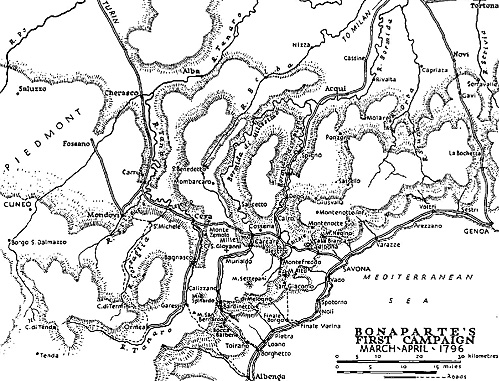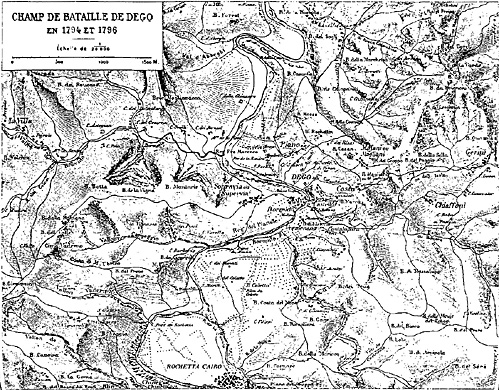It is March 1796. In the coastal provinces along the northern Apennine mountains, the Austrian commander, General Beaulieu is in a quandary. A large portion of his army has struck south towards French forces thought to be at the village of Voltri. They only strike air. Beaulieu is now uncertain of the location of the French Armee d'Italie. He hesitates. Meanwhile, Napoleon Bonaparte is concentrating the Armee d'ltalle for his own attack against the Sardinian and Austrians forces. Constrained by mountain roads, Beaulieu falls back north with 10,000 towards Novi and towards Alessandria, were approximately 9,000 of his command remained. Individuals can hike long distances in a day, but an orderly military formation does good in covering 20 miles, from Voltri back to Alessandria will take three days. From there to Acqui will take another two. Time is something Bonaparte will not give his opponents.
General Argenteau commands a separate element of Beaulleu's offense. He is pushing over the Apennines attempting to cut off any French forces between Savona and Voltri. He runs into the French under Colonel Rampon at Montenotte. Unable to dislodge the French formation after a day of serious fighting, Argenteau holds his current position against the advice of his fellow Austrian General Rukavina. He anticipates fresh Austrian units. The Terzy battalion (600) reaches Argenteau by evening with the Preiss battalion (800) moving to cover his left flank. He does not foresee the French response.
Now Rampon's forces are also reinforced with 1,500 more troops (up to 2,500) with new French units swinging into Beaulleu's right flank. These formations belong to General Messona, reinforced with a brigade from General Meyrier's division. Meyrier is not up to active field command and his division is being redistributed among other formations in the Armee d'ltalle. General LaHarpe assembles his division, aligns on Rampon, and joins the attack. As he spies the envelopment, Argenteau falls back fighting towards Dego. He has the remnants of 4 battalions (2 Anton, 1 Alvintzy and 1 Terzy). Besides this, he has 4 more at Sassello, 2 at Mloglia and 1 each at Parto, Malvenc'mo, and Acqui. However, Argenteau's morale is starting to crack.
First Battle of Dego, 14 April 1796
Close on the heels of the Austrians are the divisions of Messena and LaHarpe, The remnants of Argenteau's battalions are in and around Dego. Between Rochetta Cairo and Dego and on the right bank of the Bromida River, Messina begins a frontal assault with the 21 st and 14th DemiBrigade (DB). On his right is Lasalcette (late of Meyrier's Division) with the 1st legere and elements of the 21 st and 8th legere DB pressing the left of the Austrians. LaHarpe is the left wing of the attack. Crossing the Bromida below Cairo (towards Dego) he places a battalion of the 99th DB and his guns into position. The two remaining battalions of the 99th and the
~whole of the 70th DB of his command ford the Bromida taking Dego from the rear.
Bonaparte, believing the Austrians are out of it, starts to concentrate his forces against the Sardinians. He leaves Messina to cover this area. Now the short comings of the French Revolutionary Army come into play. On the move for two days of fighting, the soldiers disperse for food, loot, and billets. No patrols are conducted and outposts are not placed. Such undiscipline will hamper Bonaparte in this campaign.
On the night of the 14th, Beaulieu arrives at Acqui ahead of this forces. He finds a broken Argenteau and his shatter battalions. He is not game to continue. He will write of aiding his Sardinian allies, but will make no real effort to come to their assistance.
Second Battle of Dego, 15 April 1796
Argenteau's more able subordinate Colonel Vukassovitch is on the move. Vukassovitch is not Beaulieu. Marching by night, he directly attacks with 5 battalions (1 Alvintzy, 1 Nadasty, 2 Carlstadter, and Preiss - between 3 to 4,000). The French are utterly surprised. He recaptures the guns and assigns infantry to work them. Messena is not in Dego, but Cairo. He spends the morning collecting his scattered soldiers. LaHarpe and Menard who were 'in Cairo and Carcare are marched back. For a second time in as many days, these same soldiers of the Armee d'Italie are assaulting Dego. This time the Austrians are not demoralized parts of broken battalions. LaHarpe is on the left, Messena is in the center supported by Dommartin, with Menard on the right attacking the Austrian left. These Austrians fight hard. When one French column under General Caussel is driven off, the Austrians leave their entrenchments and follow until General Victor covers the retreat. Finally, the weight of numbers prevails and Vukassovitch retires back toward Acqui. Casualties for the French run approximately 1,000, and the Austrians over 1,700. Battalion Preiss reports 671 lost from 800. It is out of the campaign.
This time Bonaparte sends elements following to ascertain further Austrian intentions and to provide earlier warning of any forward action by Beaulieu. These battered Austrian battalions from the second day at Dego further convince Beaulieu to go on the defensive. Bonaparte is starting to achieve his objectives.
Nota Bene- These are three small unit battles fought with mainly infantry and some supporting artillery. Forces amount to seven battalions on the Austrian side and 6 DBs on the French at any one time. As the map shows the confined space can well fit on our tabletops. On an unusual "roll" the Austrians actually get a better and aggressive commander in the form of Vukassovitch. Additionally, in a role often accredited to the French Old Guard, the Austrians infantry man the recaptured artillery pieces.
Act I Scene 2 "Then we'll kill them"
The Sardinians are very quiet while their Austrian allies are being thrashed within a short distance of their positions. If Vukassovitch could hear the guns and take an initiative so could have the forces of King Victor Amadeus, under Lieutenant General Michael Colli. The Sardinians tend to their own fears.
General Serurier is marching down the Tanaro river valley gathering his men, approximately 6,000. This is the left of the Armee d'Italie. General Augereau is in motion through Bardinecco. General Joubert, Augereau's left, links up with Serurier. Augereau's brigades passes through Montesemolo. Their objective is Ceva. With Serurier and Augereau masking the Sardinians, Bonaparte now changes his Line of Communications (LoC) from Altare and the coastal town of Savona, to Bardinetto and then to Loano. This reduces any potential threat along the eastern coastal approach from Voltri by the Austrians. He needn't concern himself with the Austrians.
General Colli occupies a series of strongly entrenched positions stretching around Ceva to an area south of Mombarcaro, where he has a detachment. He also has detachments in Lesegno and Mondovi. His forces number between 6 to 7,000. On the 16th, Augereau mounts a frontal attack which is repulsed. He reorganizes for a second assault on the 18th, to be aided by a strike against the Sardinian right by one of three columns under Serurier. Augereau is maneuvering to Mombarcaro around the left flank of the Sardinian position. Here Augereau's flank is joined by Dommartin's brigade. Under the cover of darkness, Colli withdrawals, moving ~back in the direction of Mondovi to avoid the pending assault.
In pursuit on the 19th, Serurier's forces move into San Michele but are unable to reform on the other side of the village. The troops, in the presence of the enemy, break rank to loot and plunder for food. The Sardinians exploit the situation. They reform and attack throwing the French out of San Michele, costing the French around a 1,000 men. Bonaparte issues orders to attack again on the 20th but is convinced by his division commanders to give them an extra day to restore discipline and to bring up the artillery. On the night of the 20th, Colli again abandons his positions before the French and retires north towards Mondovi. The French find
their quarry has flown. Once again in chase, Serurier catches the Sardinian rearguard in the village of Vico, between San Michele and Mondovi. The defenders are thrown out, and with Meynier's column's enveloping their flanks, the Sardinians rearguard is forced among their main elements in confusion through Modovi and across the Ellere River.
The area around Modovi provides sufficient resources to feed the Armee. Orders are issued to impose severe punishment for further undisciplined acts by the soldiers. The cavalry and artillery are redistributed among the divisions. The elements of the Armee d'ltalle covering the French left flank back to Coll de Tenda are ordered down the Tanaro to join the main body.
On the 23rd, with the road to the capital of Turin nearly open, King Victor Amadeus sends his envoys to ask for peace and directs Colli to negotiate with Bonaparte for an armistice. Bonaparte engages in these exchanges but doesn't slacken his pressure on the Sardinian forces. Serurier and Messena's commands continue to follow and foil Colli's attempts to cover Turin. On the 25th the French are into Fossano and Cherasco. After hours of fruitless discussion, the Sardinians accede to Bonaparte's terms. It is the morning of the 28th of April.
The French attain possession of the region south of the Tanaro and the fortresses of Cueno, Ceva, and Tortona. Sardinia will remain neutral, but allow the transit of French forces. In a month since taking command, Bonaparte has lead the Armee d'Italie from the barren slopes of the Apennines to the fertile regions of the Piedmont. He has removed another power and its army from the First Coalition. He is giving life to the Armee d'Italie to carry it and himself to even greater achievements in the year. Now the Austrians.
Act 2 Scene I "The Race to Mantua"


Back to Table of Contents -- MWAN 84
Back to MWAN List of Issues
Back to MagWeb Magazine List
© Copyright 1996 by Hal Thinglum.
This article appears in MagWeb (Magazine Web) on the Internet World Wide Web.
Other military history articles and gaming articles are available at http://www.magweb.com